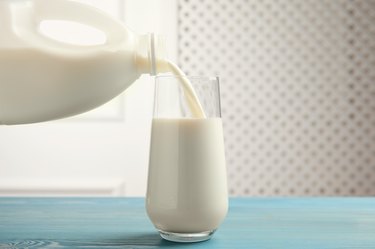
Most ingredients in the cook's repertoire occasionally need to be thickened. For example, milk might be thickened as part of a sauce, in a custard, or as part of a dessert preparation. People with dysphagia -- difficulty swallowing -- might need to thicken milk so they can drink it without choking. Several suitable techniques exist for thickening milk, depending on the intended purpose.
Evaporate Moisture Content Through Reduction
Video of the Day
One of the most common ways to thicken any liquid, including milk, is to simmer it until most of its moisture content has evaporated. This makes the milk thicker for the simple and obvious reason that it is less watery. Its fats, proteins and sugars become more concentrated, giving the thickened, reduced milk a rich, distinctive flavor. Although Western cooking seldom uses this technique, Indian cooking, especially Indian desserts, make heavy use of reduced milks.
Video of the Day
Add Starch Thickeners
In sauces and soups, you would usually thicken milk by adding a starch such as flour or cornstarch. For example, in a classic bechamel sauce, the cook first prepares a roux by stirring butter and flour together in a pan. This precooks the flour, removing its starchy taste. When you add milk or a liquid and whisk, the roux thickens to a velvety-smooth texture. Use the reduced milk in scalloped potatoes and soups with a milky base, such as potato and leek.
Quick-mixing flour is precooked at the factory, then dried and milled to a smooth powder. It is mixed into cold water to form a slurry. Prevent lumps by stirring the slurry completely before adding it into the hot milk. Continue whisking and watch as it gels quickly. Cornstarch works the same way, but as a purified starch it provides more thickening power.
Custards Use Thickening Agents
Many custards, especially dessert custards, work by thickening milk or cream. In custards, the thickening agent is eggs. The eggs must be whisked thoroughly into the milk off the heat and then heated very gently, which causes their proteins to congeal. To further thicken the custard, measure 1 tablespoon of cornstarch into 1 cup of milk and slowly heat. Overheating causes the proteins to breakdown and split. If that occurs, place the pan in a basin of cold water and whisk feverishly to bring the elements back together.
Because the strands of protein are dispersed in the milk, they set to a soft gel, rather than the familiar firm texture. Some custards, such as pastry cream, also incorporate a starch like cornstarach to provide a firmer, more reliable thickening effect, such as that used in a Napoleon or a pie. Be careful with the amount of cornstarch you use as the taste of the starch may take over the taste of the custard.
Thickening for Dysphagia
Thickening milk for people with dysphagia is necessary to aid in swallowing. Heating milk changes its flavor, and makes it less appealing as a beverage, but thin milk is more difficult to swallow than thickened milk. Specialized thickeners such as Thick-It is used for that purpose and contain gum-based ingredients such as xanthan gum, which are widely used in manufactured foods as thickeners and gelling agents. You can stir these into milk, fruit juices and other beverages, and thicken them without altering their flavor or appearance.